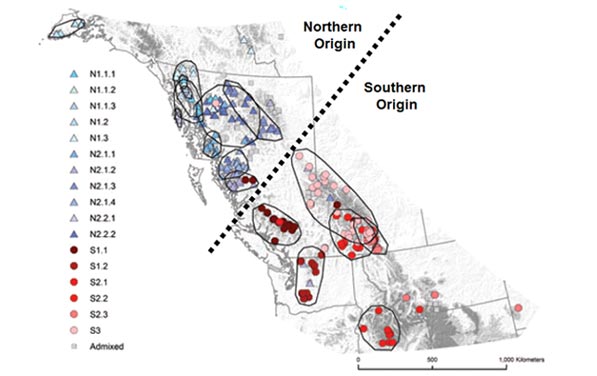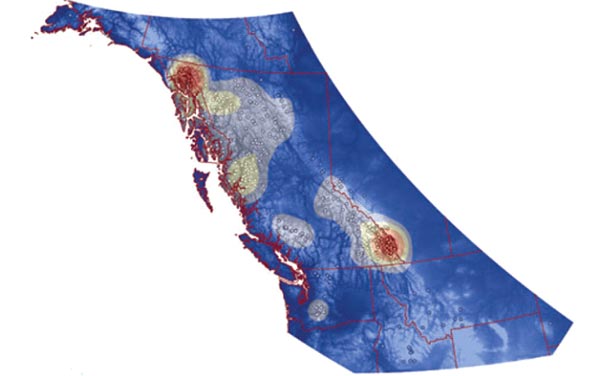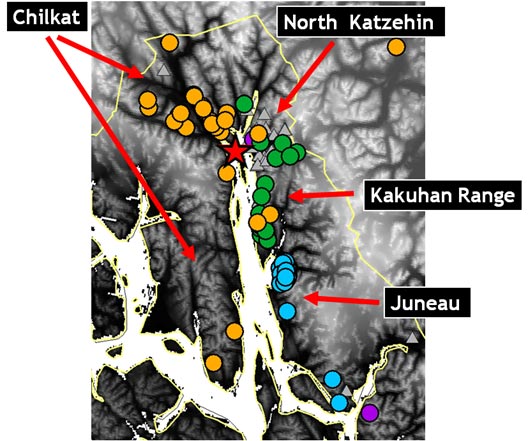Mountain Goat Research
Mountain goat genetics

Population genetics is a powerful tool for understanding the biology of mountain goat populations. In 2006, the Alaska Department of Fish and Game began collaboration with Canadian population geneticist Aaron Shafer of the University of Alberta and University of Laval. The Alaska Department of Fish and Game furnished mountain goat DNA samples (i.e. small tissue samples collected during capture activities or submitted by hunters) and other biological data from throughout Alaska. In the lab, Aaron Shafer conducted detailed genetic analyses that ultimately lead to a wealth of information about mountain goat population structure, relatedness and the role of landscape characteristics in modulating movement among populations.
This research has revealed a strong degree of affinity to discrete ridge systems indicating that movement across low elevation habitats is extremely limited. For example, mountain goat populations on either side of Berners Bay (a distance of 3.5 miles) are genetically distinct. This occurs because mountain goats are habitat specialists and strongly select steep, rugged terrain and display a strong aversion of flat, open habitats: this is reflected in their genetic patterns. Additional findings revealed that the Haines area is one of two genetic diversity hotspots in North America (the other is located in the Canadian Rockies).
Among the most surprising findings was evidence that mountain goats on Baranof island are comprised of two distinct genetic lineages-one that is a “carbon copy” of the Tracy Arm area (the location from where mountain goats were transplanted to Baranof in 1924) and the other representing a refugial lineage that has occurred on Baranof island since the last glacial maximum. The documentation of a “cryptic refugia” for mountain goats on Baranof island was a surprise because previously biologists believed that the extant population on Baranof island was exclusively derived from the 1924 transplant (though Russian fur trading diaries from the early-1800’s note mountain goats in Baranof island).
Overall, understanding the population genetic structure of mountain goats has important implications for management and conservations and will help explain why we see variation in mountain goat body size and horn morphology between different populations in Alaska; yet, more work remains to be done on this topic.
The Alaska Department of Fish and Game continues to request tissue samples from hunters throughout Alaska in order to continue this important research. In this regard, hunters play an important and much appreciated role in the continued success of this research project. Hunters can submit small tissue samples (the size of a pencil eraser) to their local ADF&G offices and such samples will be included in the statewide archive.
Project Collaborators
University of Alberta/University of Laval (Aaron Shafer), Alaska Department of Fish and Game
Publications
Shafer, A. B. A., S. D. Cote, and D. W. Coltman. 2011. Hot spots of genetic diversity descended from multiple Pliestocene refugia in an alpine ungulate. Evolution, 65: 125-138
Shafer, A. B. A., K. S. White, S. D. Cote, D. W. Coltman. 2011. Deciphering translocations from relicts in Baranof Island mountain goats: Is an endemic genetic lineage at risk? Conservation Genetics 12:1261-1268.
Shafer, A. B. A., J. M. Northrup, K. S. White, M. S. Boyce, S. D. Cote, D. W. Coltman. 2012. Habitat selection predicts genetic relatedness in an alpine ungulate. Ecology, 93:1317-1329.
From Alaska Fish and Wildlife News
- Mountain Goats: Mysteries and Management
- Mountain Goats in Focus: Biologists Share Management and Research
More Information
For more information please contact: Aaron Shafer (shaferab@gmail.com) or Kevin White (kevin.white@alaska.gov)
Additional Figures



